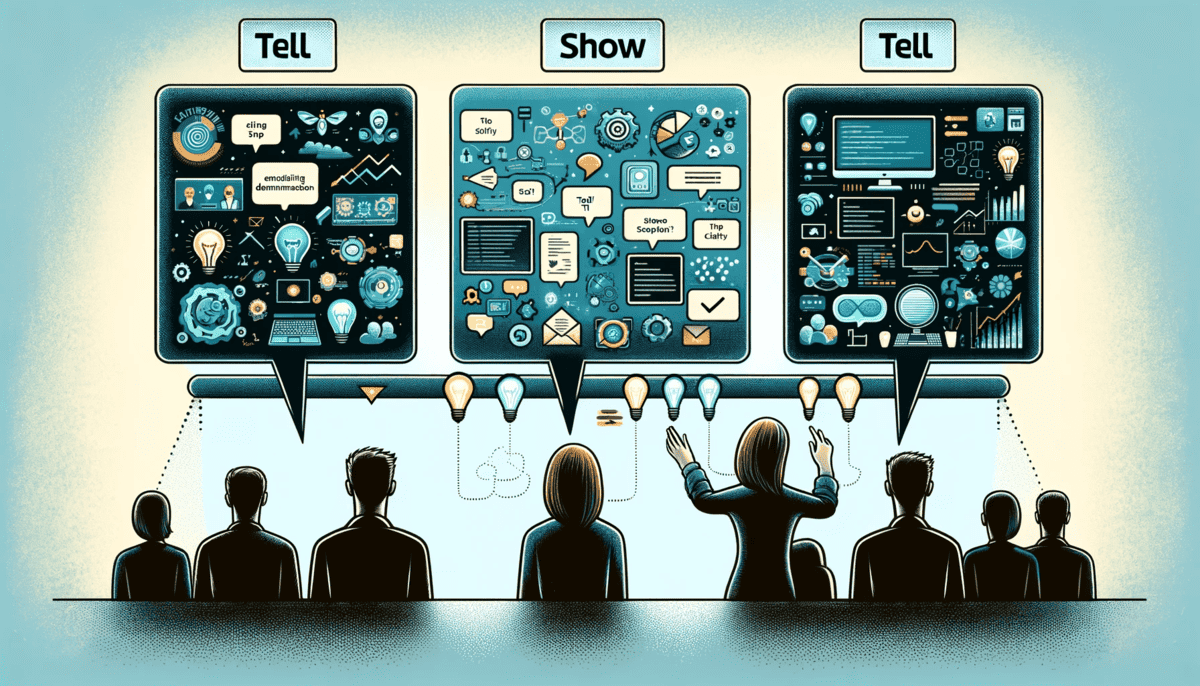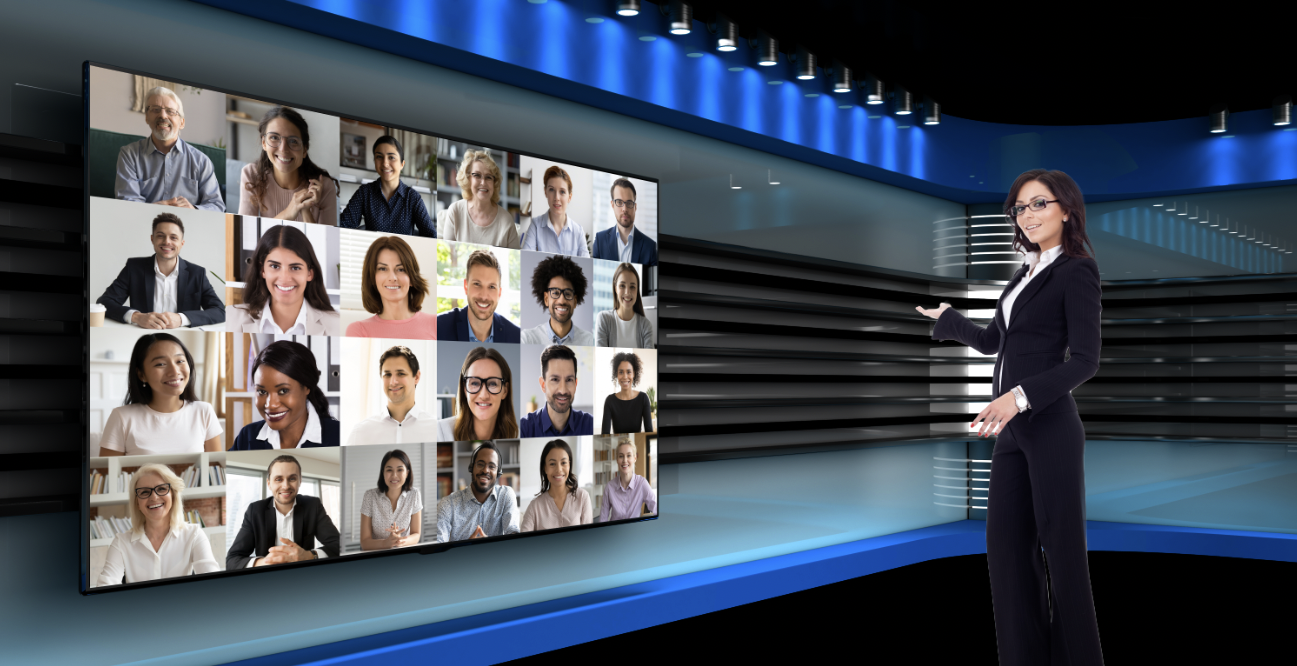Tell-Show-Tell: The Most Powerful Demo Technique
Tell-Show-Tell is one of the most powerful techniques a presenter can use in a software demo. This post is a conversation about Tell-Show-Tell...

Are you finding it challenging to create compelling, organized presentations that resonate with your audience? Tell-Show-Tell is a proven technique to help you streamline your message delivery, captivate your listeners, and ensure that your key points are understood and retained. By mastering this technique, you can create presentations that leave a lasting impact and help you achieve your goals.
The Tell-Show-Tell technique is a strategic approach to structuring demos. Its purpose is to simplify and clarify your message to ensure the audience understands how your solution helps them achieve their goals. This technique helps guide each prospect across the bridge, from their current state to recognizing the benefits of your solution.
Many demos tend to be feature-focused overviews that lack engagement and interaction. Tell-Show-Tell turns a demo into an interactive conversation about how your solution solves meaningful problems. Let's explore how you can use the Tell-Show-Tell technique to enhance your demo's effectiveness, engage your prospects, and ultimately drive them to switch from their current solution to yours.
Before diving in, access our free training to learn more about how to build your personal brand and develop trust with prospects.
The Opening Tell is where you start to gain your audience's attention and build a connection with them. It may be tempting to immediately start showing the features of your software, especially when time is limited. Still, without first providing some background information and context, your audience may struggle to understand the relevance of these features. Therefore, it is essential to lay the groundwork by providing some context before diving into the features of your software.
Why it matters: The Opening Tell is particularly important for setting the scene. By communicating why your audience should care, you establish a narrative in which they can see themselves. This acknowledges their challenges and presents a tailored solution that meets their needs.
Staying on Message: It's easy to veer off course during a demo. The Opening Tell communicates and validates the scope of a demo topic. It makes it easier to stay focused.
Engagement: You invite the audience to be a part of the story by reflecting their needs and challenges. This enables the audience to see themselves in the solution and make the journey personal and impactful.
Now that you've set the stage, it's time to prove the value of your solution. Proof could be anything from software to presentation slides, whiteboarding, or a strategic discussion. This step showcases how your solution addresses the specific needs and challenges highlighted in the Opening Tell.
Stay Focused: If you find yourself saying things like "also" or "that reminds me of..." you may be demonstrating outside of the scope of your Opening Tell and committing the "I Love this Part of my Solution" demo crime. Keep the demo concise and to the point.
Sprinkle Benefits: As you demonstrate your solution, sprinkle in how it saves time, reduces errors, or enhances productivity. These benefit statements reinforce the value of your solution, making your case even more compelling.
Learn more about how you can build an automated demo by combining 2Win's training with Consensus' automation platform.
The Closing Tell is where you emphasize your solution's Key Operational Benefit. Focus on the impact to your audience's daily operations and strategic goals.
Personalized Benefits: Benefits should articulate how features translate into real-world advantages for your audience. Use names, roles, and specific scenarios to make these benefits resonate on a personal level.
Value Pyramid: If your solution offers a key differentiator, now's the time to elevate the conversation. Use "So You Can" to walk up the value pyramid.
Adopting the Tell-Show-Tell framework turns feature-focused demos into well-structured narratives that keep you on track and ensure your message resonates. This method helps you engage in meaningful conversations with your audience.
The Tell-Show-Tell approach provides a natural rhythm to your demos and meetings, guiding you through each segment with purpose and clarity. It's like having a map for your conversation, knowing exactly where you are and where you're headed next. This structure encourages participation, turning a potential monologue into an open discussion.
Tell-Show-Tell is useful in more than just demos; it also helps structure conversations. Rather than getting lost in lengthy discussions, this method emphasizes clarity and relevance.
By thinking in Tell-Show-Tell, you become more adept at steering conversations and keeping them aligned with your objectives. It prompts you to continuously ask, "Have I achieved what I set out to do in this meeting or demo?"
The Tell-Show-Tell technique is important for maintaining focus and having productive outcomes.
Managing Time Effectively: Time management is critical in any presentation or meeting. The Tell-Show-Tell approach keeps you mindful of the clock, encouraging you to prioritize discussions that drive toward your goal. It helps identify when to dive deeper into a topic and when to move on, maximizing the efficiency of your interaction.
Concluding with a Call to Action (CTA): Perhaps most importantly, this structured approach allows you to always close with a CTA. Ending a meeting without clear next steps can delay decision making and require additional follow-up meetings. The Tell-Show-Tell framework reminds you to close with a purpose, building momentum for future engagements.
Clarify and Connect: Use the Opening Tell to conduct discovery on the fly as needed. This demonstrates active listening and tailors the demo to the audience's specific interests.
Agile Tell-Show-Tell: Have a series of short, impactful stories or "vignettes" ready to go. These "vignettes" can be particularly useful in discovery demos or when presenting earlier in the sales cycle and needing to adapt on the fly.
At the heart of the Tell-Show-Tell method is the power to steer the narrative in a direction that captures and sustains audience engagement. This structure does more than convey information; it draws your audience into an immersive experience. It's about creating a connection that goes beyond the surface, tapping into the audience's needs, challenges, and aspirations. By aligning your flow with the Tell-Show-Tell method, you make every moment count, turning passive listeners into active participants, who are invested in the journey.
Have questions about any of the above? Our team of presales, sales, and client success experts are ready to help you advance.

Tell-Show-Tell is one of the most powerful techniques a presenter can use in a software demo. This post is a conversation about Tell-Show-Tell...

When your executives take the virtual stage at your upcoming Sales Kickoff (SKO), a story needs to be told. Here’s the scenario. 2020 has been an...

Tell Show Tell is perhaps our most famous and foundational 2Win demonstration technique and is at the heart of our Demo2Win program. It is the...